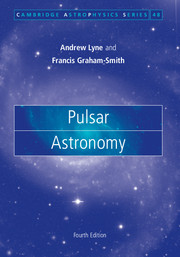Book contents
- Frontmatter
- Contents
- List of illustrations
- Preface
- 1 The discovery of pulsars
- 2 Neutron stars
- 3 Telescopes and techniques
- 4 The distances of the pulsars
- 5 Pulsar timing
- 6 Timing and astrometry of binary pulsars
- 7 Timing irregularities
- 8 The Galactic population of pulsars
- 9 The Crab and Vela Pulsars
- 10 Other young pulsars
- 11 Millisecond and binary pulsars
- 12 Accretion-powered X-ray pulsars
- 13 Magnetars
- 14 Supernovae and their remnants
- 15 Integrated pulse profiles
- 16 Individual pulses
- 17 Location of emitting regions
- 18 Radiation processes
- 19 The emission mechanisms
- 20 Interstellar scintillation and scattering
- 21 The interstellar magnetic field
- 22 Achievements and prospects
- References
- Index
2 Neutron stars
Published online by Cambridge University Press: 05 March 2012
- Frontmatter
- Contents
- List of illustrations
- Preface
- 1 The discovery of pulsars
- 2 Neutron stars
- 3 Telescopes and techniques
- 4 The distances of the pulsars
- 5 Pulsar timing
- 6 Timing and astrometry of binary pulsars
- 7 Timing irregularities
- 8 The Galactic population of pulsars
- 9 The Crab and Vela Pulsars
- 10 Other young pulsars
- 11 Millisecond and binary pulsars
- 12 Accretion-powered X-ray pulsars
- 13 Magnetars
- 14 Supernovae and their remnants
- 15 Integrated pulse profiles
- 16 Individual pulses
- 17 Location of emitting regions
- 18 Radiation processes
- 19 The emission mechanisms
- 20 Interstellar scintillation and scattering
- 21 The interstellar magnetic field
- 22 Achievements and prospects
- References
- Index
Summary
Broadly speaking, when a normal star has exhausted its sources of energy, it collapses under its own gravity. A star with the density of normal matter then ends up in one of three possible states: white dwarf, neutron star or black hole. The extent of the collapse depends on the mass of the progenitor star; the most massive become black holes, and the least massive become white dwarfs. The progenitors of neutron stars have a limited intermediate range of mass, about 8 to 20 solar masses (M⊙ = 2 × 1033 g). It follows from the statistical distribution of stellar masses that more than 95% of stars end their lives as white dwarfs without further collapse.
The formation of a white dwarf is a smooth and continuous process; as nuclear fuel becomes exhausted, a core grows within an expanding outer shell, the total gravitational collapse of the core being prevented by the pressure of electron degeneracy. If and when the mass of the core exceeds 1.4 solar masses (M⊙), this pressure is insufficient to resist the increasing force of self-gravity and to prevent the further collapse of such a degenerate core to a neutron star. At this second stage of collapse it is the pressure of neutron degeneracy that balances gravity. The collapse to a neutron star is catastrophic; within a few seconds a large proportion of the gravitational potential energy of the star is released, and the event is observed as a supernova (Type II; see Chapter 14).
- Type
- Chapter
- Information
- Pulsar Astronomy , pp. 16 - 26Publisher: Cambridge University PressPrint publication year: 2012

